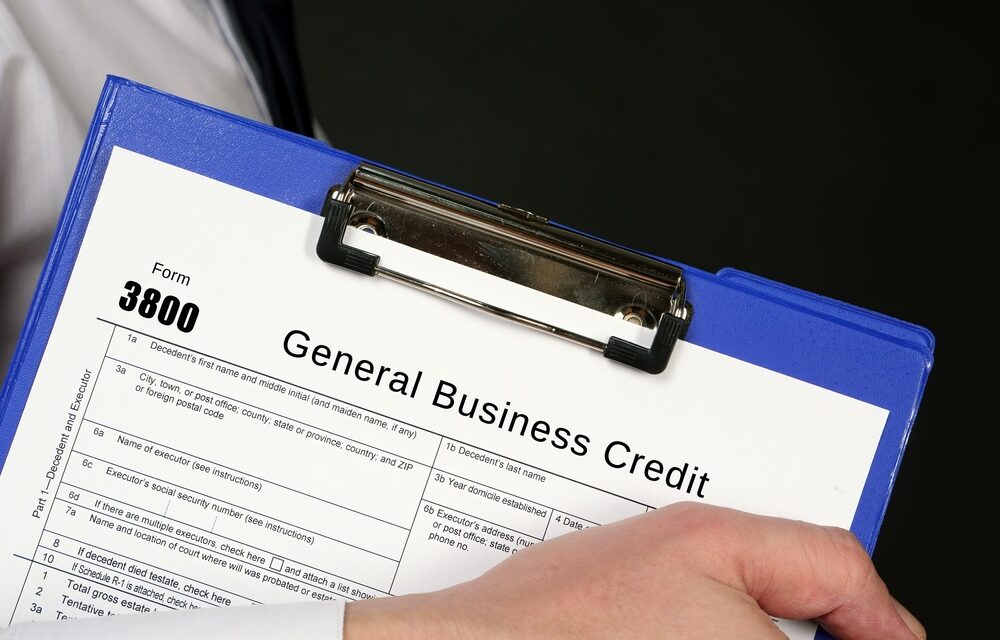Abstract: Tax credits are far more valuable than tax deductions. Unlike a deduction, which reduces a business’s taxable income, a credit reduces the business’s tax liability dollar for dollar. Tax credits aren’t unlimited, however. For businesses, the aggregate value of tax credits may be limited by the general business credit (GBC). This article explains how the GBC works. A brief sidebar lists specific individual tax credits included under the GBC.
Make the most of the general business credit
Tax credits are far more valuable than tax deductions. Unlike a deduction, which reduces a business’s taxable income, a credit reduces the business’s tax liability dollar for dollar. Tax credits aren’t unlimited, however. For businesses, the aggregate value of tax credits may be limited by the general business credit (GBC), found in Internal Revenue Code Section 38. Taxpayers should familiarize themselves with the GBC so they can understand the value of their business credits and identify tax-saving opportunities.
How it works
The GBC isn’t a tax credit in the usual sense. Rather, it’s a collection of dozens of business-related credits scattered throughout the tax code. (See the sidebar, “What’s included in the GBC?”) Each credit must be claimed separately, according to its specific rules and using the relevant tax forms. Taxpayers that claim more than one credit, however, must also file Form 3800 to report the aggregate value of those credits and calculate the overall allowable credit under the GBC.
The GBC limits total credits in a given year to the excess (if any) of a taxpayer’s net income tax over the greater of:
- The tentative alternative minimum tax (AMT) for the year, or
- 25% of the amount by which the taxpayer’s net regular tax liability exceeds $25,000.
For purposes of calculating the GBC, “net income tax” is the sum of the taxpayer’s regular tax liability and AMT liability, reduced by certain non-GBC credits. “Net regular tax liability” is regular tax liability reduced by certain credits.
The GBC limit essentially prevents taxpayers from using credits to avoid AMT. In recent years, that hasn’t been an issue for C corporations, because the Tax Cuts and Jobs Act (TCJA) repealed the corporate AMT. Although the recently enacted Inflation Reduction Act established a new corporate minimum tax for corporations with “book profits” over $1 billion for tax years beginning after December 31, 2022, it generally doesn’t limit the GBC.
The AMT for individuals still exists, though the TCJA substantially increased the AMT exemption and made other changes that mean fewer taxpayers are subject to it. Nevertheless, AMT still may limit the use of the GBC by individual taxpayers such as sole proprietors, partners and S corporation shareholders.
Treatment of unused credits
If the limits prevent a taxpayer from using all of the GBC, the unused credit may be carried back one year and then, if unused credit remains, carried forward up to 20 years. In a given year, the GBC is used in the following order:
- Carryforwards to that year, starting with the oldest ones,
- GBC earned in that year, and
- The carryback to that year.
These ordering rules essentially apply a first-in, first-out (FIFO) approach that minimizes the risk that unused credits will expire. Still, taxpayers with a large surplus of credits may risk losing credits that can’t be used within the 20-year carryforward period. Fortunately, the tax code provides some relief for taxpayers in this position.
Deduction for unused credits
To prevent taxpayers from “double-dipping,” the tax code generally doesn’t permit them to claim a tax credit and a tax deduction based on the same expenses. Thus, in the year that a GBC is generated, taxpayers generally must treat a portion of its expenses (equal to the amount of the credit) as nondeductible.
In many cases, when a credit is lost, Section 196 allows the lost credit amount to be claimed as a deduction. If the credit is lost because the 20-year carryforward period expires, the taxpayer may claim the deduction in the following tax year. If it’s lost because the taxpayer dies or ceases to exist, the deduction may be claimed for the year of death or cessation.
The Sec. 196 deduction may provide a tax-saving opportunity for C corporations contemplating a sale. It’s common for buyers to acquire a company’s stock and then make an election to treat the transaction as a deemed asset sale for tax purposes. But this can trigger substantial taxable gains for the seller. If the seller has significant unused GBCs, it may be able to use a Sec. 196 deduction to offset some or all of those gains (because the selling corporation ceases to exist).
Secure the credits you deserve
Determining GBCs for a given year, and calculating applicable limits, can be complicated. Be sure to work with your tax advisor to make the most of these valuable credits.
Sidebar: What’s included in the GBC?
A general business credit (GBC) consists of more than 30 individual tax credits that provide incentives for a variety of business activities. Examples include:
- Alcohol fuels credit,
- Disabled access credit,
- Credit for employer Social Security and Medicare taxes paid on certain employee tips,
- Credit for small employer pension plan startup costs,
- Employer credit for paid family and medical leave,
- Employer-provided child care facilities and services credit,
- Empowerment zone employment credit,
- Investment credit,
- Low-income housing credit,
- New energy-efficient home credit,
- Orphan drug credit,
- Renewable electricity production credit,
- Research credit,
- Small employer health insurance credit,
- Work Opportunity credit, and
A portion of the credits for alternative motor vehicles, alternative fuel vehicle refueling property and new qualified plug-in electric drive motor vehicles.
Latest News
On June 9, the IRS released Announcement 2022-13, which modifies Notice 2022-3, by revising the optional standard mileage ...
At the tail end of 2021, the Internal Revenue Service (IRS) released new Schedules K-2 and K-3 effective ...
This information is current as of Sunday, November 21, 2021. On Friday, November 19, 2021, after the Congressional ...
HM&M Updates
Last month, Senior Manager, Pearl Balsara was invited to speak at the 2023 FPA DFW Annual Conference in ...
We are pleased to announce the winners of the 2022 HM&M Excellence Awards. Ronna Beemer, Keith Phillips, and ...
Huselton, Morgan and Maultsby is composed of a spectacular team of individuals. During our annual What’s Happening Meeting, ...








